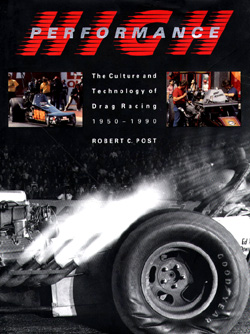|
|
|
|
 |
||
|
High Performance: by Robert C. Post Reviewed by Prometheus Williams
I was in a bit of a jam around six months ago. I'd been told that I was going to serve as webmaster for a new type of online drag racing magazine. I thought to myself great I can't wait, but I had to resolve few things for myself. Firstly, I didn't really know what the old magazines looked like, and secondly, I really didn't know anything about drag racing. So I humbly confessed my shortcomings to those more knowledgeable in the faith and was assigned the above referenced tome to lead me from the land of the neophyte to the blessed halls of nitro-induced contentedness. Robert Post presents to the reader the definitive work on the development and history of drag racing. He is an admitted enthusiast of the sport, but more than that he is also its preeminent scholar. He serves as curator for the Smithsonian's Nation American Museum of American History and is an accomplished author. Perhaps his greatest accomplishment in compiling High performance is that he wrote the history of a movement while the progenitors of that movement were still alive and able to offer their incites on the sport that they had founded. Post writes: Drag racing is an activity with a history so brief that people still around were there at the start. They recall how it began as a hobby among young men infatuated with speed and power - 'hot rodders,' they were called. They have seen it become a compelling spectacle with a complex web of commercial relationships. And they have seen women impelled into mainstream roles to a degree far beyond what prevails in most similar activities. Post does not attempt to tell us when drag racing began. He admits that evidently as long as there had been automobiles people had been racing them. Instead, he begins in southern California and describes the situations and history that solidified drag racing as an organized, albeit loosely initially, sport. He then takes the reader through to the modern era of the sport. This book does not portend to be an old-timer's reminiscence of the good old days and how they never would have believed that the sport has grown so much ……. It is a story of the passion, obsession, romance, and enthusiasm inherent in racing that was coupled with the dynamic technological explosion of the twentieth century yielding a movement that became a sport. The development and implementation of that technology is the frame of this work and the narratives are built around it. The reader learns of the developments in technology from the men and women who engineered and experimented with the technology that makes drag racing the sport that it is today. If you want to learn more about the history and technology behind the passion, I highly recommend this work. As an aside, DRO's own denizens John Raffa, Dave Wallace, Jr., Chris Martin, Dave Densmore, and Jeff Burk are all referenced, thanked and/or featured in the work, and I am not aware of any better endorsement than that.
|
||
|
Copyright 1999-2001, Drag Racing Online and Racing Net Source |
||
 "This
book will be the bible of drag racing for future generations" - Don
Garlits
"This
book will be the bible of drag racing for future generations" - Don
Garlits